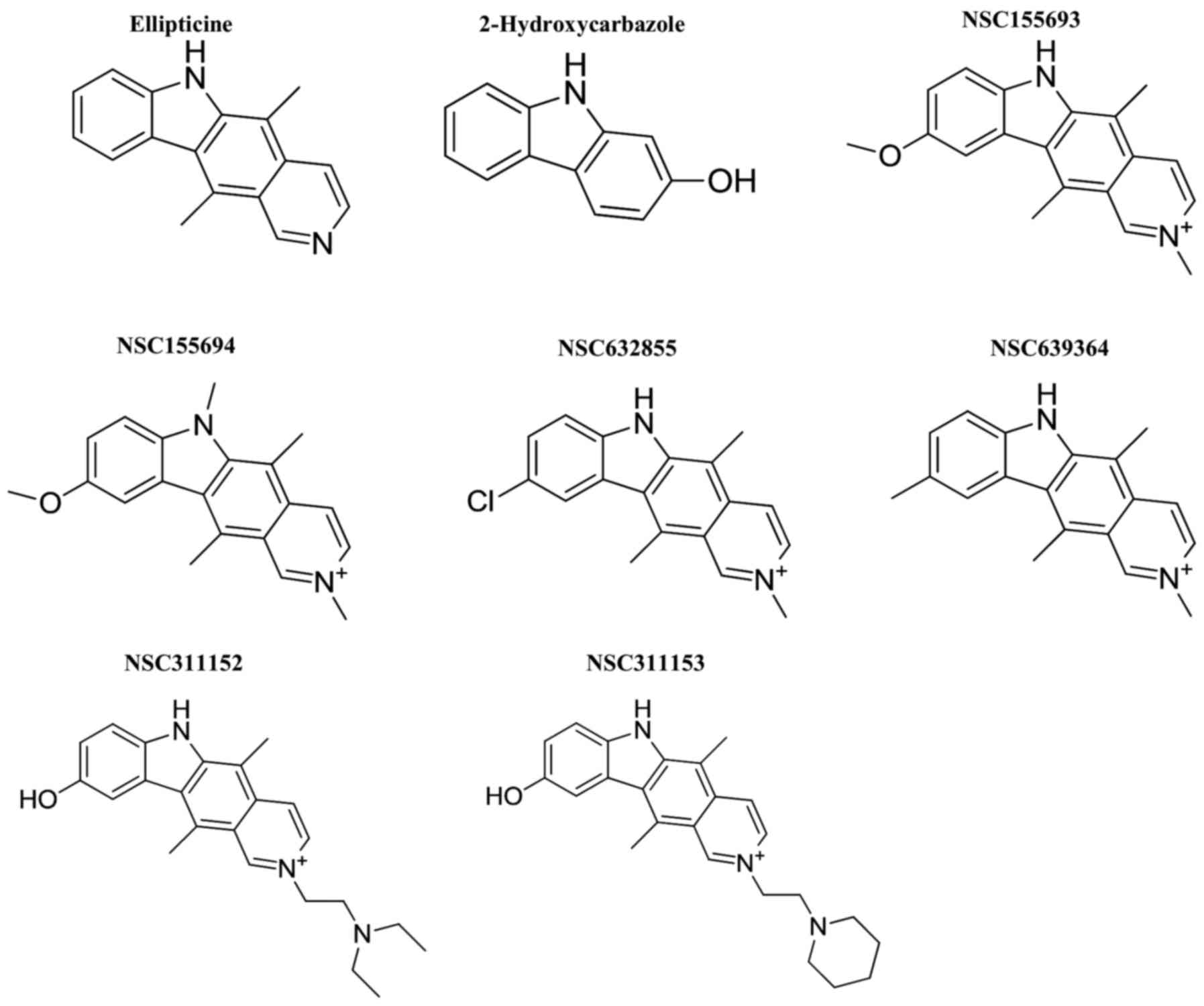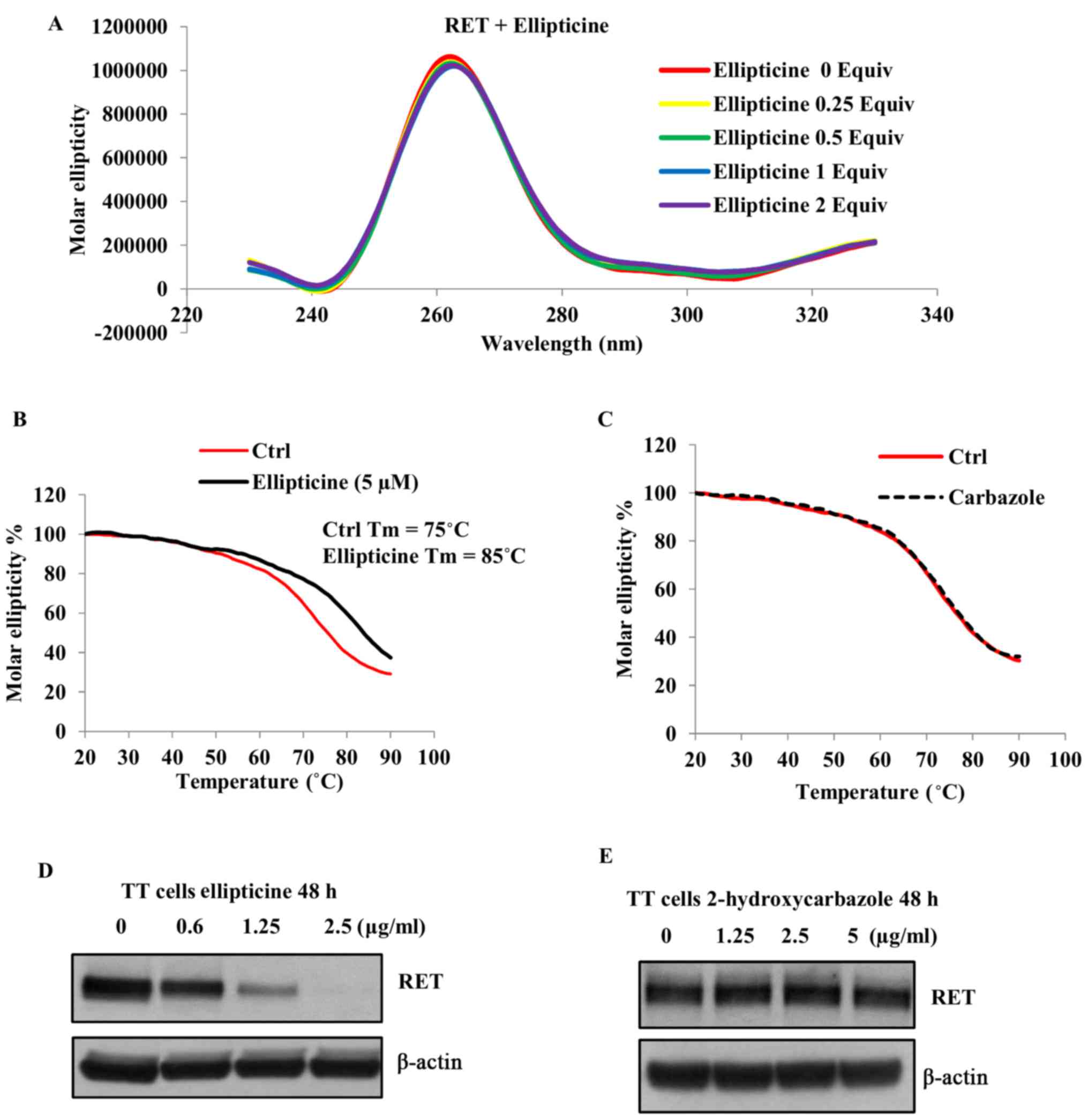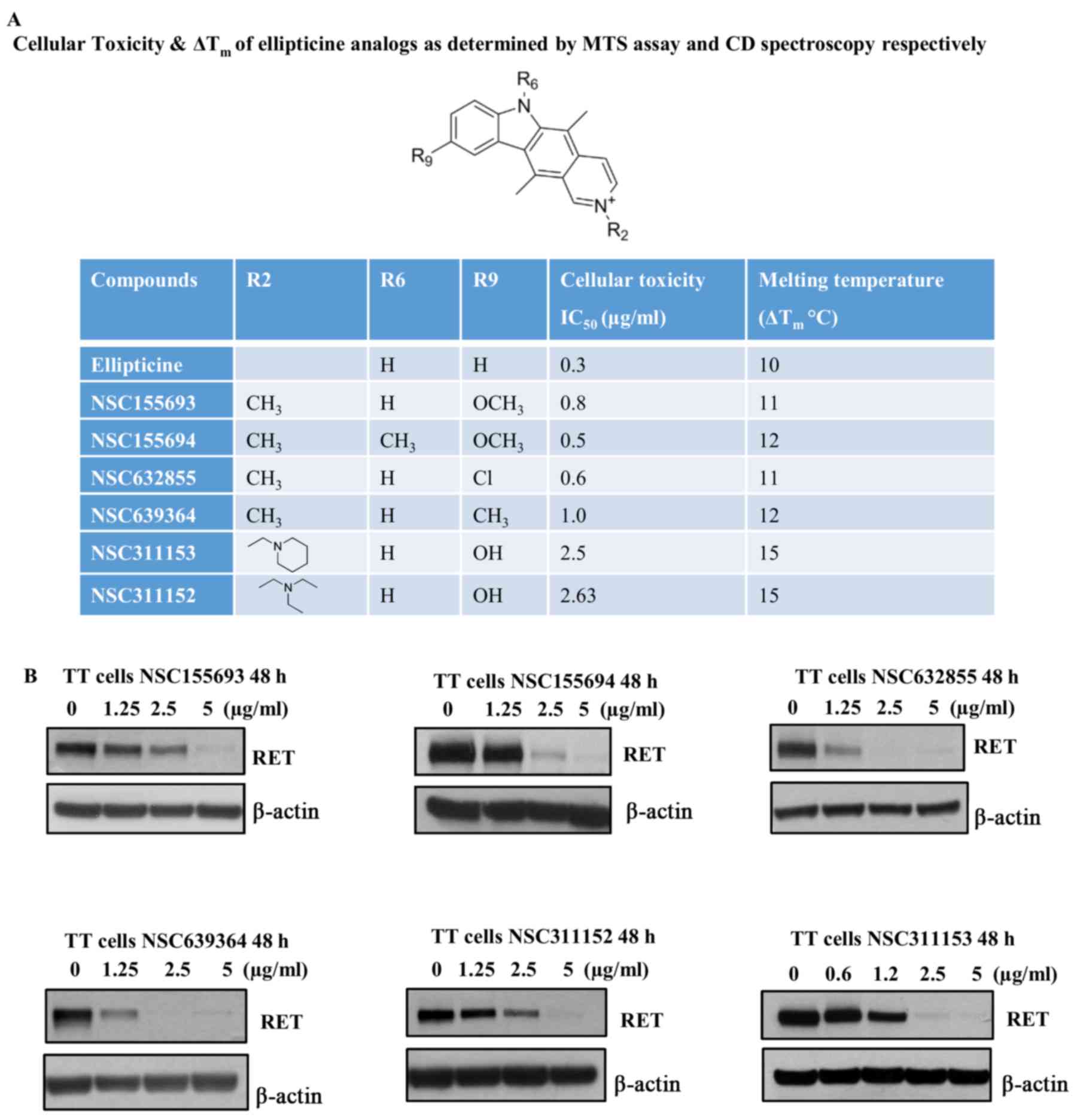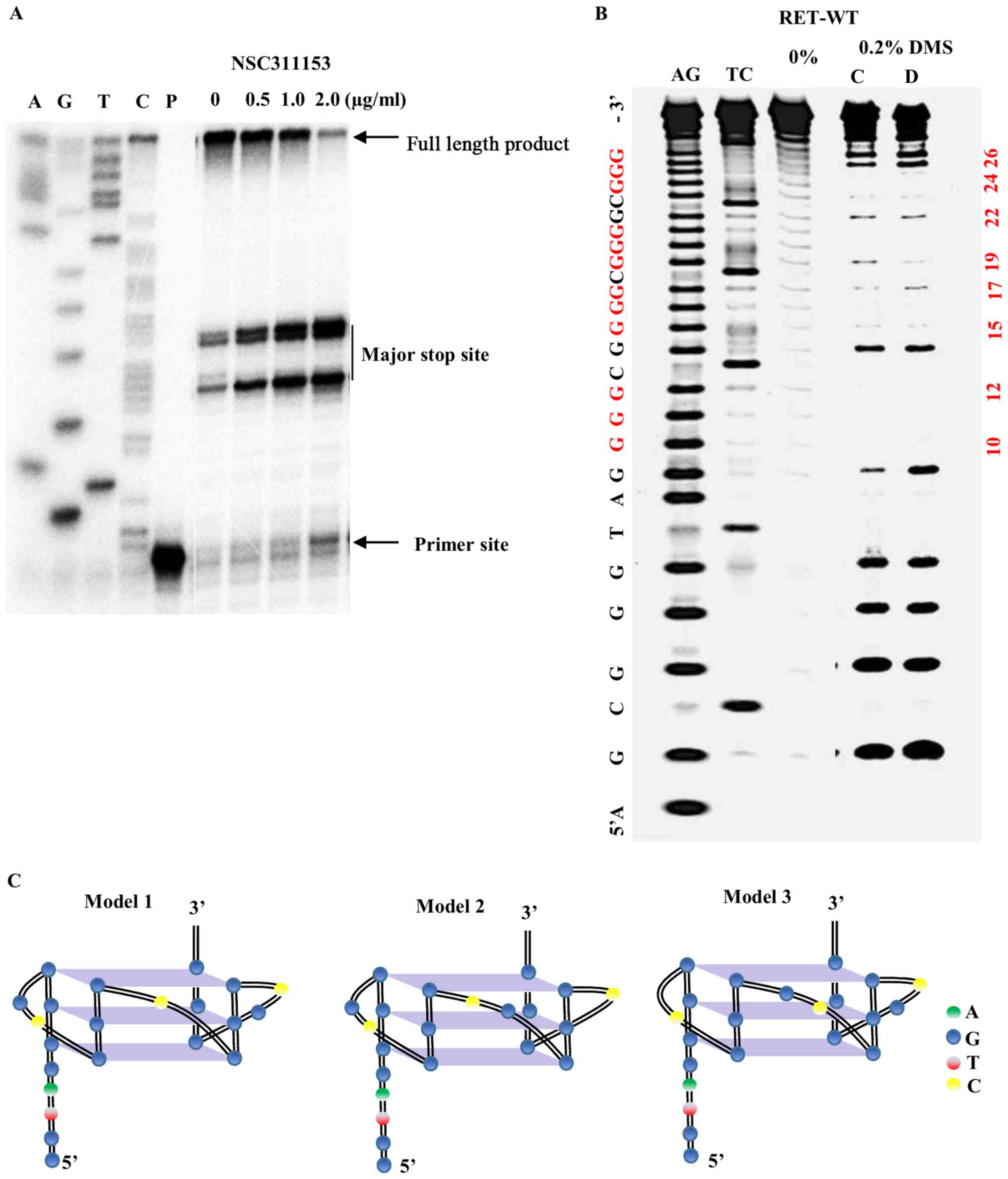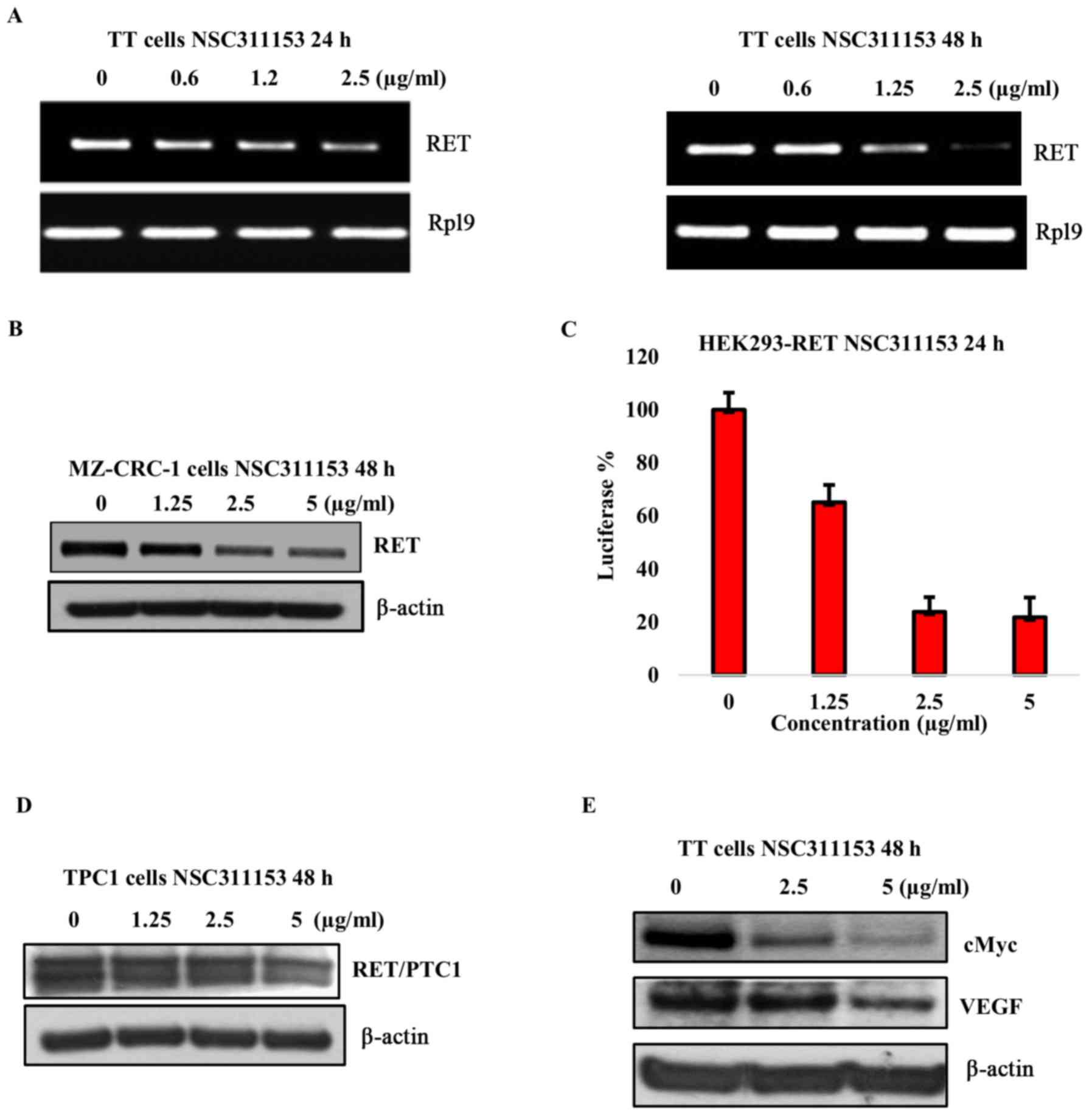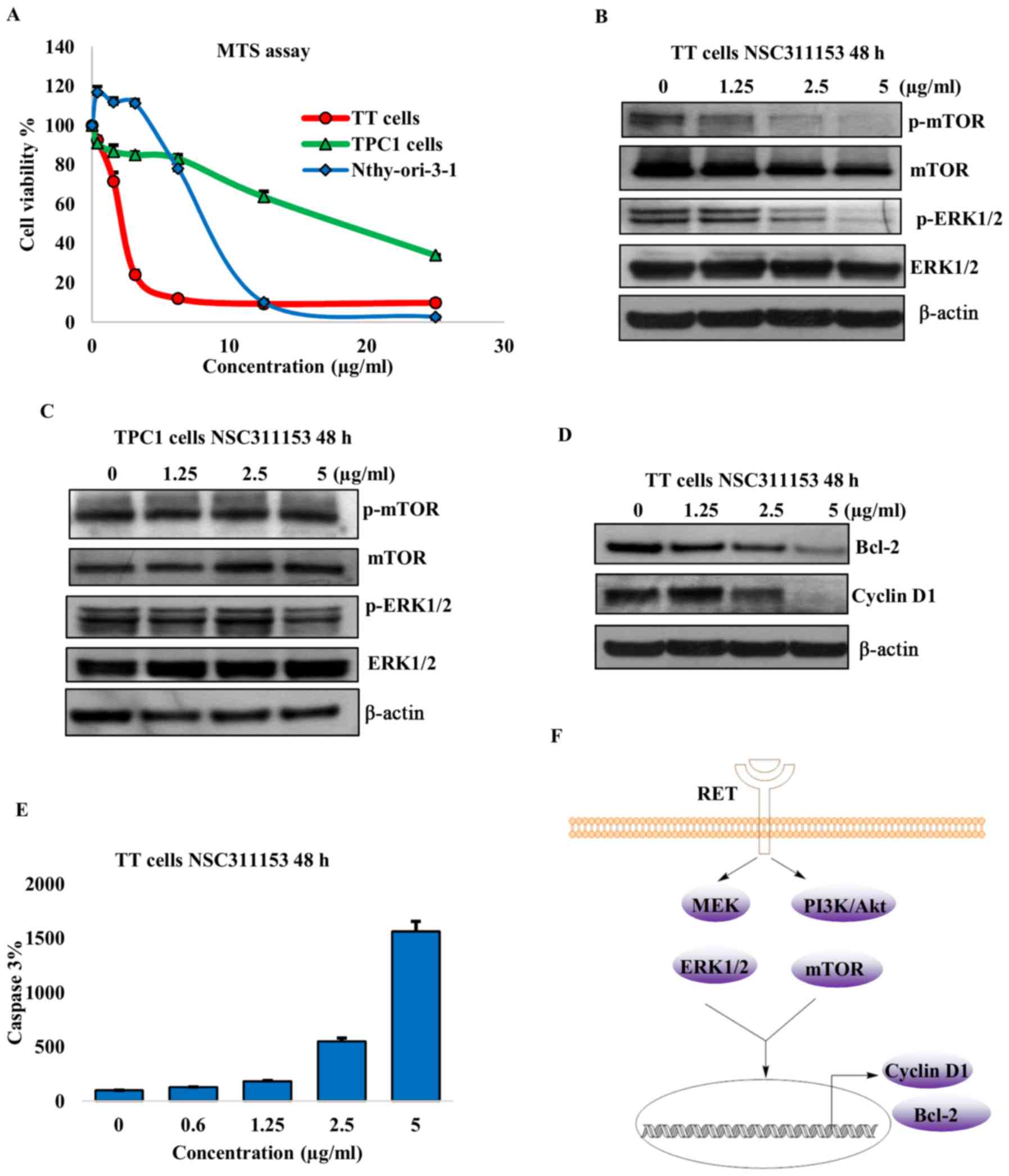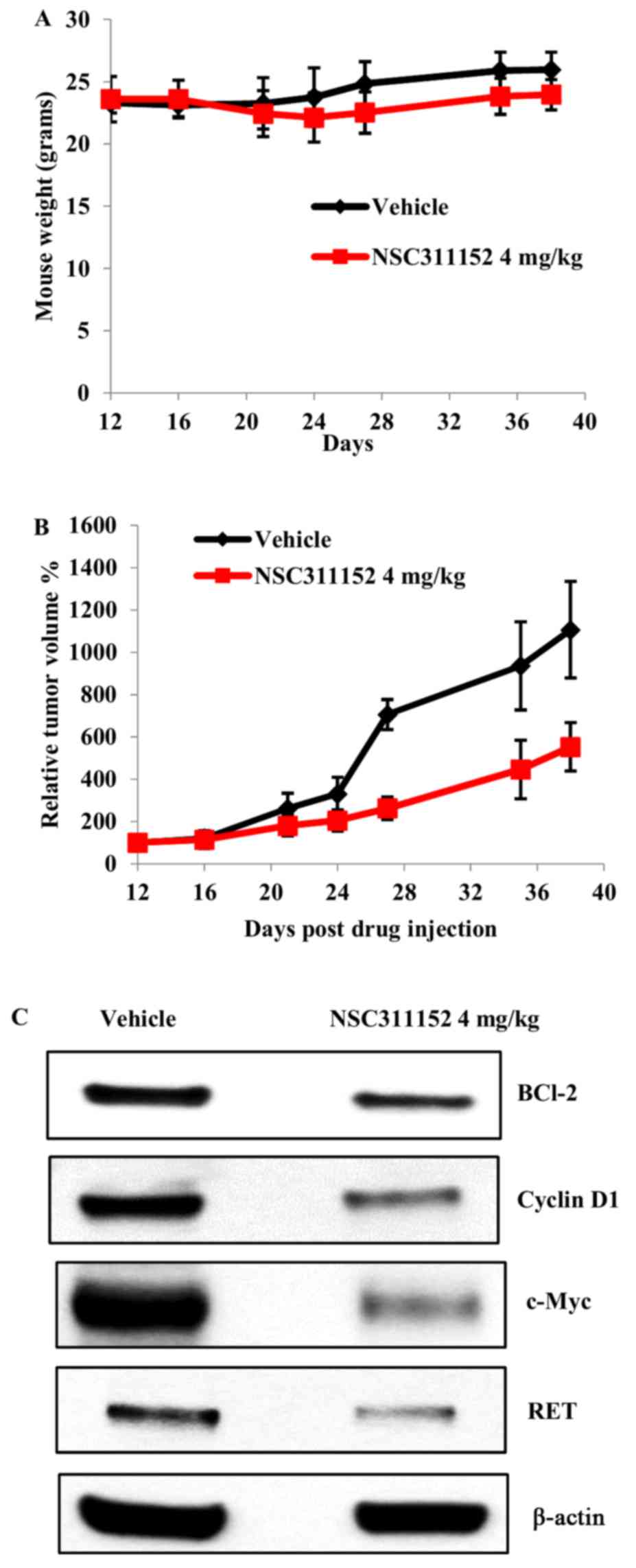|
1
|
Takahashi M and Cooper GM: ret
transforming gene encodes a fusion protein homologous to tyrosine
kinases. Mol Cell Biol. 7:1378–1385. 1987. View Article : Google Scholar : PubMed/NCBI
|
|
2
|
Patel A, Harker N, Moreira-Santos L,
Ferreira M, Alden K, Timmis J, Foster K, Garefalaki A, Pachnis P,
Andrews P, et al: Differential RET signaling pathways drive
development of the enteric lymphoid and nervous systems. Sci
Signal. 5:ra552012. View Article : Google Scholar : PubMed/NCBI
|
|
3
|
Takahashi M, Buma Y, Iwamoto T, Inaguma Y,
Ikeda H and Hiai H: Cloning and expression of the ret
proto-oncogene encoding a tyrosine kinase with two potential
transmembrane domains. Oncogene. 3:571–578. 1988.PubMed/NCBI
|
|
4
|
Takahashi M, Buma Y and Hiai H: Isolation
of ret proto-oncogene cDNA with an amino-terminal signal sequence.
Oncogene. 4:805–806. 1989.PubMed/NCBI
|
|
5
|
Anders J, Kjar S and Ibáñez CF: Molecular
modeling of the extracellular domain of the RET receptor tyrosine
kinase reveals multiple cadherin-like domains and a calcium-binding
site. J Biol Chem. 276:35808–35817. 2001. View Article : Google Scholar : PubMed/NCBI
|
|
6
|
Durbec P, Marcos-Gutierrez CV, Kilkenny C,
Grigoriou M, Wartiowaara K, Suvanto P, Smith D, Ponder B,
Costantini F, Saarma M, et al: GDNF signalling through the Ret
receptor tyrosine kinase. Nature. 381:789–793. 1996. View Article : Google Scholar : PubMed/NCBI
|
|
7
|
Trupp M, Arenas E, Fainzilber M, Nilsson
AS, Sieber BA, Grigoriou M, Kilkenny C, Salazar-Grueso E, Pachnis
V, Arumäe U, et al: Functional receptor for GDNF encoded by the
c-ret proto-oncogene. Nature. 381:785–789. 1996. View Article : Google Scholar : PubMed/NCBI
|
|
8
|
Cosma MP, Cardone M, Carlomagno F and
Colantuoni V: Mutations in the extracellular domain cause RET loss
of function by a dominant negative mechanism. Mol Cell Biol.
18:3321–3329. 1998. View Article : Google Scholar : PubMed/NCBI
|
|
9
|
Iwashita T, Asai N, Murakami H, Matsuyama
M and Takahashi M: Identification of tyrosine residues that are
essential for transforming activity of the ret proto-oncogene with
MEN2A or MEN2B mutation. Oncogene. 12:481–487. 1996.PubMed/NCBI
|
|
10
|
Drosten M, Hilken G, Böckmann M, Rödicker
F, Mise N, Cranston AN, Dahmen U, Ponder BA and Pützer BM: Role of
MEN2A-derived RET in maintenance and proliferation of medullary
thyroid carcinoma. J Natl Cancer Inst. 96:1231–1239. 2004.
View Article : Google Scholar : PubMed/NCBI
|
|
11
|
Pitt SC and Chen H: The
phosphatidylinositol 3-kinase/akt signaling pathway in medullary
thyroid cancer. Surgery. 144:721–724. 2008. View Article : Google Scholar : PubMed/NCBI
|
|
12
|
Melillo RM, Santoro M, Ong SH, Billaud M,
Fusco A, Hadari YR, Schlessinger J and Lax I: Docking protein FRS2
links the protein tyrosine kinase RET and its oncogenic forms with
the mitogen-activated protein kinase signaling cascade. Mol Cell
Biol. 21:4177–4187. 2001. View Article : Google Scholar : PubMed/NCBI
|
|
13
|
Chen Z, Qi X, Fei J, Yu X, Zhao Y, Zhao J,
Jin H, Wang J, Ying R and Zhang X: Multiple endocrine neoplasia
type 2A caused by a p.C618RRET proto-oncogene mutation in a Chinese
pedigree. Zhonghua Yi Xue Yi Chuan Xue Za Zhi. 31:348–351. 2014.In
Chinese. PubMed/NCBI
|
|
14
|
Lodish MB and Stratakis CA: RET oncogene
in MEN2, MEN2B, MTC and other forms of thyroid cancer. Expert Rev
Anticancer Ther. 8:625–632. 2008. View Article : Google Scholar : PubMed/NCBI
|
|
15
|
Mulligan LM, Kwok JB, Healey CS, Elsdon
MJ, Eng C, Gardner E, Love DR, Mole SE, Moore JK, Papi L, et al:
Germ-line mutations of the RET proto-oncogene in multiple endocrine
neoplasia type 2A. Nature. 363:458–460. 1993. View Article : Google Scholar : PubMed/NCBI
|
|
16
|
Asai N, Iwashita T, Matsuyama M and
Takahashi M: Mechanism of activation of the ret proto-oncogene by
multiple endocrine neoplasia 2A mutations. Mol Cell Biol.
15:1613–1619. 1995. View Article : Google Scholar : PubMed/NCBI
|
|
17
|
Aboelnaga EM and Ahmed RA: Difference
between papillary and follicular thyroid carcinoma outcomes: An
experience from Egyptian institution. Cancer Biol Med. 12:53–59.
2015.PubMed/NCBI
|
|
18
|
Milan SA, Sosa JA and Roman SA: Current
management of medullary thyroid cancer. Minerva Chir. 65:27–37.
2010.PubMed/NCBI
|
|
19
|
Cabanillas ME, Hu MI, Jimenez C, Grubbs EG
and Cote GJ: Treating medullary thyroid cancer in the age of
targeted therapy. Int J Endocr Oncol. 1:203–216. 2014. View Article : Google Scholar : PubMed/NCBI
|
|
20
|
de Groot JW, Links TP, Plukker JT, Lips CJ
and Hofstra RM: RET as a diagnostic and therapeutic target in
sporadic and hereditary endocrine tumors. Endocr Rev. 27:535–560.
2006. View Article : Google Scholar : PubMed/NCBI
|
|
21
|
Plaza-Menacho I, Burzynski GM, de Groot
JW, Eggen BJ and Hofstra RM: Current concepts in RET-related
genetics, signaling and therapeutics. Trends Genet. 22:627–636.
2006. View Article : Google Scholar : PubMed/NCBI
|
|
22
|
Wells SA Jr and Santoro M: Targeting the
RET pathway in thyroid cancer. Clin Cancer Res. 15:7119–7123. 2009.
View Article : Google Scholar : PubMed/NCBI
|
|
23
|
Shin YJ, Kumarasamy V, Camacho D and Sun
D: Involvement of G-quadruplex structures in regulation of human
RET gene expression by small molecules in human medullary thyroid
carcinoma TT cells. Oncogene. 34:1292–1299. 2015. View Article : Google Scholar
|
|
24
|
Kumarasamy VM, Shin YJ, White J and Sun D:
Selective repression of RET proto-oncogene in medullary thyroid
carcinoma by a natural alkaloid berberine. BMC Cancer. 15:5992015.
View Article : Google Scholar : PubMed/NCBI
|
|
25
|
Andrew SD, Capes-Davis A, Delhanty PJ,
Marsh DJ, Mulligan LM and Robinson BG: Transcriptional repression
of the RET proto-oncogene by a mitogen activated protein
kinase-dependent signalling pathway. Gene. 298:9–19. 2002.
View Article : Google Scholar : PubMed/NCBI
|
|
26
|
Bachetti T, Borghini S, Ravazzolo R and
Ceccherini I: An in vitro approach to test the possible role of
candidate factors in the transcriptional regulation of the RET
proto-oncogene. Gene Expr. 12:137–149. 2005. View Article : Google Scholar : PubMed/NCBI
|
|
27
|
Andrew SD, Delhanty PJ, Mulligan LM and
Robinson BG: Sp1 and Sp3 transactivate the RET proto-oncogene
promoter. Gene. 256:283–291. 2000. View Article : Google Scholar : PubMed/NCBI
|
|
28
|
Guo K, Pourpak A, Beetz-Rogers K, Gokhale
V, Sun D and Hurley LH: Formation of pseudosymmetrical G-quadruplex
and i-motif structures in the proximal promoter region of the RET
oncogene. J Am Chem Soc. 129:10220–10228. 2007. View Article : Google Scholar : PubMed/NCBI
|
|
29
|
Sun D, Guo K, Rusche JJ and Hurley LH:
Facilitation of a structural transition in the
polypurine/polypyrimidine tract within the proximal promoter region
of the human VEGF gene by the presence of potassium and
G-quadruplex-interactive agents. Nucleic Acids Res. 33:6070–6080.
2005. View Article : Google Scholar : PubMed/NCBI
|
|
30
|
Sun D and Hurley LH: The importance of
negative superhelicity in inducing the formation of G-quadruplex
and i-motif structures in the c-Myc promoter: Implications for drug
targeting and control of gene expression. J Med Chem. 52:2863–2874.
2009. View Article : Google Scholar : PubMed/NCBI
|
|
31
|
Parkinson GN, Lee MP and Neidle S: Crystal
structure of parallel quadruplexes from human telomeric DNA.
Nature. 417:876–880. 2002. View Article : Google Scholar : PubMed/NCBI
|
|
32
|
Burge S, Parkinson GN, Hazel P, Todd AK
and Neidle S: Quadruplex DNA: Sequence, topology and structure.
Nucleic Acids Res. 34:5402–5415. 2006. View Article : Google Scholar : PubMed/NCBI
|
|
33
|
Paoletti C, Le Pecq JB, Dat-Xuong N, Juret
P, Garnier H, Amiel JL and Rouesse J: Antitumor activity,
pharmacology, and toxicity of ellipticines, ellipticinium, and
9-hydroxy derivatives: Preliminary clinical trials of
2-methyl-9-hydroxy ellipticinium (NSC 264-137). Recent Results
Cancer Res. 74:107–123. 1980. View Article : Google Scholar : PubMed/NCBI
|
|
34
|
Rouëssé J, Spielmann M, Turpin F, Le
Chevalier T, Azab M and Mondésir JM: Phase II study of elliptinium
acetate salvage treatment of advanced breast cancer. Eur J Cancer.
29A:856–859. 1993. View Article : Google Scholar : PubMed/NCBI
|
|
35
|
Fossé P, René B, Charra M, Paoletti C and
Saucier JM: Stimulation of topoisomerase II-mediated DNA cleavage
by ellipticine derivatives: Structure-activity relationship. Mol
Pharmacol. 42:590–595. 1992.PubMed/NCBI
|
|
36
|
Barrett JF, Gootz TD, McGuirk PR, Farrell
CA and Sokolowski SA: Use of in vitro topoisomerase II assays for
studying quinolone antibacterial agents. Antimicrob Agents
Chemother. 33:1697–1703. 1989. View Article : Google Scholar : PubMed/NCBI
|
|
37
|
Ghosh S, Kar A, Chowdhury S and Dasgupta
D: Ellipticine binds to a human telomere sequence: An additional
mode of action as a putative anticancer agent? Biochemistry.
52:4127–4137. 2013. View Article : Google Scholar : PubMed/NCBI
|
|
38
|
Brown RV, Danford FL, Gokhale V, Hurley LH
and Brooks TA: Demonstration that drug-targeted down-regulation of
MYC in non-Hodgkins lymphoma is directly mediated through the
promoter G-quadruplex. J Biol Chem. 286:41018–41027. 2011.
View Article : Google Scholar : PubMed/NCBI
|
|
39
|
Han H, Hurley LH and Salazar M: A DNA
polymerase stop assay for G-quadruplex-interactive compounds.
Nucleic Acids Res. 27:537–542. 1999. View Article : Google Scholar
|
|
40
|
Sun D and Hurley LH: Biochemical
techniques for the characterization of G-quadruplex structures:
EMSA, DMS footprinting, and DNA polymerase stop assay. Methods Mol
Biol. 608:65–79. 2010. View Article : Google Scholar
|
|
41
|
Riss TL, Moravec RA, Niles AL, Duellman S,
Benink HA, Worzella TJ and Minor L: Cell Viability Assays. Assay
Guidance Manual. Sittampalam GS, Coussens NP, Nelson H, et al:
Bethesda (MD): 2004, View Article : Google Scholar
|
|
42
|
Gray DM, Gray CW, Mou TC and Wen JD: CD of
single-stranded, double-stranded, and G-quartet nucleic acids in
complexes with a single-stranded DNA-binding protein. Enantiomer.
7:49–58. 2002. View Article : Google Scholar : PubMed/NCBI
|
|
43
|
González V, Guo K, Hurley L and Sun D:
Identification and characterization of nucleolin as a c-myc
G-quadruplex-binding protein. J Biol Chem. 284:23622–23635. 2009.
View Article : Google Scholar : PubMed/NCBI
|
|
44
|
Zhu W, Hai T, Ye L and Cote GJ: Medullary
thyroid carcinoma cell lines contain a self-renewing
CD133+ population that is dependent on ret
proto-oncogene activity. J Clin Endocrinol Metab. 95:439–444. 2010.
View Article : Google Scholar
|
|
45
|
Grieco M, Santoro M, Berlingieri MT,
Melillo RM, Donghi R, Bongarzone I, Pierotti MA, Della Porta G,
Fusco A and Vecchio G: PTC is a novel rearranged form of the ret
proto-oncogene and is frequently detected in vivo in human thyroid
papillary carcinomas. Cell. 60:557–563. 1990. View Article : Google Scholar : PubMed/NCBI
|
|
46
|
Fusco A, Grieco M, Santoro M, Berlingieri
MT, Pilotti S, Pierotti MA, Della Porta G and Vecchio G: A new
oncogene in human thyroid papillary carcinomas and their
lymph-nodal metastases. Nature. 328:170–172. 1987. View Article : Google Scholar : PubMed/NCBI
|
|
47
|
Nikiforov YE: RET/PTC rearrangement in
thyroid tumors. Endocr Pathol Spring. 13:3–16. 2002. View Article : Google Scholar
|
|
48
|
Schweppe RE: Thyroid cancer cell line
misidentification: An update. J Clin Endocrinol Metab. 98:956–957.
2013. View Article : Google Scholar : PubMed/NCBI
|
|
49
|
Tong Q, Li Y, Smanik PA, Fithian LJ, Xing
S, Mazzaferri EL and Jhiang SM: Characterization of the promoter
region and oligomerization domain of H4 (D10S170), a gene
frequently rearranged with the ret proto-oncogene. Oncogene.
10:1781–1787. 1995.PubMed/NCBI
|
|
50
|
Baldin V, Lukas J, Marcote MJ, Pagano M
and Draetta G: Cyclin D1 is a nuclear protein required for cell
cycle progression in G1. Genes Dev. 7:812–821. 1993. View Article : Google Scholar : PubMed/NCBI
|
|
51
|
Tsujimoto Y: Role of Bcl-2 family proteins
in apoptosis: Apoptosomes or mitochondria? Genes Cells. 3:697–707.
1998. View Article : Google Scholar
|
|
52
|
McCubrey JA, Steelman LS, Chappell WH,
Abrams SL, Wong EW, Chang F, Lehmann B, Terrian DM, Milella M,
Tafuri A, et al: Roles of the Raf/MEK/ERK pathway in cell growth,
malignant transformation and drug resistance. Biochim Biophys Acta.
1773:1263–1284. 2007. View Article : Google Scholar
|
|
53
|
Khayat D, Borel C, Azab M, Paraisot D,
Malaurie E, Bouloux C and Weil M: Phase I study of Datelliptium
chloride, hydrochloride given by 24-h continuous intravenous
infusion. Cancer Chemother Pharmacol. 30:226–228. 1992. View Article : Google Scholar : PubMed/NCBI
|
|
54
|
Jain S: The many faces of RET dysfunction
in kidney. Organogenesis. 5:177–190. 2009. View Article : Google Scholar
|
|
55
|
Matuszczyk A, Petersenn S, Bockisch A,
Gorges R, Sheu SY, Veit P and Mann K: Chemotherapy with doxorubicin
in progressive medullary and thyroid carcinoma of the follicular
epithelium. Horm Metab Res. 40:210–213. 2008. View Article : Google Scholar : PubMed/NCBI
|
|
56
|
Terezakis SA and Lee NY: The role of
radiation therapy in the treatment of medullary thyroid cancer. J
Natl Compr Canc Netw. 8:532–540; quiz 541. 2010. View Article : Google Scholar : PubMed/NCBI
|
|
57
|
Ferrari SM, Fallahi P, Politti U,
Materazzi G, Baldini E, Ulisse S, Miccoli P and Antonelli A:
Molecular targeted therapies of aggressive thyroid cancer. Front
Endocrinol (Lausanne). 6:1762015.
|
|
58
|
Wells SA Jr, Robinson BG, Gagel RF, Dralle
H, Fagin JA, Santoro M, Baudin E, Elisei R, Jarzab B, Vasselli JR,
et al: Vandetanib in patients with locally advanced or metastatic
medullary thyroid cancer: A randomized, double-blind phase III
trial. J Clin Oncol. 30:134–141. 2012. View Article : Google Scholar
|
|
59
|
Elisei R, Schlumberger MJ, Müller SP,
Schöffski P, Brose MS, Shah MH, Licitra L, Jarzab B, Medvedev V,
Kreissl MC, et al: Cabozantinib in progressive medullary thyroid
cancer. J Clin Oncol. 31:3639–3646. 2013. View Article : Google Scholar : PubMed/NCBI
|
|
60
|
Chau NG and Haddad RI: Vandetanib for the
treatment of medullary thyroid cancer. Clin Cancer Res. 19:524–529.
2013. View Article : Google Scholar
|
|
61
|
Yakes FM, Chen J, Tan J, Yamaguchi K, Shi
Y, Yu P, Qian F, Chu F, Bentzien F, Cancilla B, et al: Cabozantinib
(XL184), a novel MET and VEGFR2 inhibitor, simultaneously
suppresses metastasis, angiogenesis, and tumor growth. Mol Cancer
Ther. 10:2298–2308. 2011. View Article : Google Scholar : PubMed/NCBI
|
|
62
|
Carlomagno F, Guida T, Anaganti S, Vecchio
G, Fusco A, Ryan AJ, Billaud M and Santoro M: Disease associated
mutations at valine 804 in the RET receptor tyrosine kinase confer
resistance to selective kinase inhibitors. Oncogene. 23:6056–6063.
2004. View Article : Google Scholar : PubMed/NCBI
|
|
63
|
Koga K, Hattori Y, Komori M, Narishima R,
Yamasaki M, Hakoshima M, Fukui T and Maitani Y: Combination of RET
siRNA and irinotecan inhibited the growth of medullary thyroid
carcinoma TT cells and xenografts via apoptosis. Cancer Sci.
101:941–947. 2010. View Article : Google Scholar : PubMed/NCBI
|
|
64
|
Agrawal N, Dasaradhi PV, Mohmmed A,
Malhotra P, Bhatnagar RK and Mukherjee SK: RNA interference:
Biology, mechanism, and applications. Microbiol Mol Biol Rev.
67:657–685. 2003. View Article : Google Scholar : PubMed/NCBI
|
|
65
|
Gavrilov K and Saltzman WM: Therapeutic
siRNA: Principles, challenges, and strategies. Yale J Biol Med.
85:187–200. 2012.PubMed/NCBI
|
|
66
|
Sun D, Guo K and Shin YJ: Evidence of the
formation of G-quadruplex structures in the promoter region of the
human vascular endothelial growth factor gene. Nucleic Acids Res.
39:1256–1265. 2011. View Article : Google Scholar :
|
|
67
|
Siddiqui-Jain A, Grand CL, Bearss DJ and
Hurley LH: Direct evidence for a G-quadruplex in a promoter region
and its targeting with a small molecule to repress c-MYC
transcription. Proc Natl Acad Sci USA. 99:11593–11598. 2002.
View Article : Google Scholar : PubMed/NCBI
|



